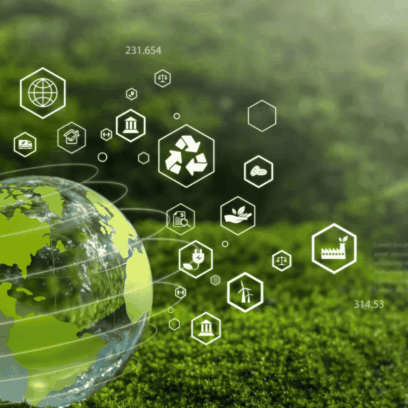Investing in Nature As Part of Your Sustainability Strategy

Beyond carbon neutrality, nature plays a pivotal role in global sustainability, offering solutions to combat climate change and restore biodiversity.
When discussing sustainability, carbon footprints are often what first come to mind, especially with many countries and businesses making public commitments and taking actions to reach net-zero emissions. Although this focus on reducing and removing carbon emissions is immensely important for the health of our planet, one important aspect of sustainability has often been overlooked—nature. Over time, human activities such as pollution, deforestation, overfishing, and mining have degraded Earth’s ecosystems. These conditions endanger many species, made evident by the 69% decrease in wildlife populations between 1970 and 2018. Nature loss also puts economies at risk, as businesses and governments rely on natural resources for agricultural production, energy generation, and much more. This destruction of nature has the potential to reduce global GDP by $2.7 trillion annually by 2030.
Nature restoration, carbon neutrality, and climate change are all closely linked. As greenhouse gas (GHG) emissions continue to rise, the impacts of climate change become more severe, and ecosystems suffer. On the other hand, nature can act as a powerful tool to help fight the climate crisis. Over the past 10 years, natural carbon sinks, such as oceans and forests, have removed 54% of the man-made emissions generated in that timeframe. By investing in nature and regeneration, biodiversity can be protected and restored, while simultaneously reducing carbon emissions and slowing global warming. In short, having a nature-centric focus is critical for sustainability strategies.
What Does It Mean to Be Nature-Positive?
The global goal for nature, set during the 15th meeting of the Conference of the Parties to the United Nations Convention on Biological Diversity (COP15), is to have humanity living in harmony with nature. This includes an increase in the area and integrity of natural ecosystems, reducing rates of extinction, and safeguarding the genetic diversity of species. To accomplish this, there is an intermediate target of having net positive improvements in nature by 2030, when compared to the 2020 baseline. Businesses can contribute to these efforts through incorporating strategies to achieve nature-positivity with urgency.
The concept of being nature-positive means halting and restoring the loss of natural processes and ecosystems. This encompasses both living nature (plant and animal species) as well as non-living nature (resources such as water and air).
The table below shows examples of how some business activities can go beyond GHG emissions reductions to help improve overall environmental health, while driving value for businesses.
Examples of Business Activities with Additional Nature Benefits
| Activity | Impact on Carbon Footprint | Additional Nature Benefits | Business Value Added |
| Planting cover crops | Cover crops absorb carbon during photosynthesis and store it in the soil. This has the potential to mitigate 10% of the agriculture sector’s GHG emissions. | The root systems of cover crops increase water infiltration, preventing runoff and soil erosion. Additionally, these plants can help bring soil nutrients to the surface, improving overall soil health. | By improving soil quality, farmers can attain higher yields, while building resilience against extreme weather events and reducing risk of loss or damage to crops. |
| Implementing nature-positive building design | The built environment has a long-lasting impact on GHG emissions as they have a long lifespan. Being eco-conscious about material choices, energy efficiency, and adding green spaces can reduce GHG emissions. | Green rooftops or landscaping can be used to add species habitats and increase biodiversity. Additionally, plants absorb less heat than concrete or asphalt, resulting in reduced local ambient temperatures that can support healthy ecosystems. | Eco-friendly buildings with efficient HVAC systems can lead to significant savings on energy bills. Using natural solutions for temperature regulation can further reduce the need for high use of air conditioning. |
| Sourcing sustainably | Supply chains often account for over 90% of a company’s total GHG emissions. There is a lot of opportunity for carbon footprint reduction, including switching to suppliers with lower emission intensity and working with suppliers to create and meet emission targets. | Sustainable sourcing can also include paying attention to the methods used by suppliers to produce goods, including considerations for how land and waterways are managed. Certifications, such as the Rainforest Alliance Certification, help ensure that goods were produced in an environmentally responsible way. | In the US, two-thirds of consumers are willing to pay a premium for sustainable products, especially those with third-party verifications. Additionally, using responsibly produced inputs can build supply chain resilience and reduce disruptions caused by weather or other events. |

FW Sustainability Report
Learn more about how Fierce Whiskers has made sustainable choices every step of the way by downloading its full sustainability report.
Skip the RFP—CarbonBetter can help
CarbonBetter Certified Offset Portfolios allow carbon buyers to participate in a variety of projects, geographies, and technologies in one simple transaction rather than navigating a lengthy and complex RFP process with multiple carbon market participants.
Learn More about CBCO 22-1Nature-Related Frameworks
Organizations around the world are beginning to recognize the importance and urgency to address the nature crisis, and have established frameworks to support this. These frameworks can be a helpful tool for businesses to structure how they approach quantifying impacts, as well as target setting and prioritization.
The Science Based Targets Network (SBTN)
SBTN is creating technical guidance for setting targets for nature and tracking progress towards them. There are five areas of focus – freshwater, land, biodiversity, ocean, and climate. Currently, the guidance for climate-related emissions reduction targets is fully released under the Science Based Targets initiative (SBTi). For the other areas, there is published guidance for Step 1: Assess, Step 2: Prioritize, and Step 3: Set Targets, with Step 4: Act and Step 5: Track coming out in 2024. Targets created under the SBTN guidelines are based on the latest scientific research and are aligned with global goals for nature.
The Taskforce on Nature-related Financial Disclosures (TNFD)
TNFD has developed a risk management and disclosure framework to help companies identify their dependencies and impacts on nature, in addition to associated risks and opportunities. This framework is currently in beta testing, with the final version to be published in September 2023. Although both the SBTN and TNFD frameworks are yet to be finalized, it is helpful for companies to get a head start on understanding what will be coming to ensure they are ready to report and disclose nature-related information.
Climate, Community, and Biodiversity (CCB)
For carbon credit project developers, the CCB standards work to provide assurance that carbon offsets deliver community and biodiversity benefits in addition to carbon reductions. Project developers must prove that the impacts on nature from the carbon offset project are net positive, ensuring negative impacts are mitigated, especially when it comes to endangered ecosystems or species. For more on CCB standards, go here.
How Companies Can Become Nature-Positive
Materiality Assessment
Before creating and implementing a nature-positive strategy, businesses need to have an understanding of what natural resources are used in business operations, how local ecosystems are impacted, and the environmental footprint of their products and services. This can include anything from wastewater management, supply chain operations, or even the coffee in the break room. Additionally, companies will need to assess their current governance structure, available funding, employee knowledge and readiness, and data capabilities to support the execution of a nature-positive business strategy. A materiality assessment can act as a framework to help evaluate environmental aspects and drive strategy development, with considerations for business risks and stakeholder priorities.
Set Goals & Targets
After gaining an understanding of their baseline impacts on nature and current operational capacity, organizations should set quantifiable and time-bound targets to work towards. Using the SBTN or other frameworks can be a helpful start.
Create a Sustainability Plan
Once targets have been set, companies will need to determine strategies and roadmaps to achieve them. Oftentimes, existing sustainability initiatives can be adapted to include nature-positive elements. Although there isn’t a one-size-fits-all approach for all businesses, some practices that can be used to achieve nature-positive goals include:
- Eliminating or replacing damaging processes: Business processes that are heavily dependent on natural resources, require high energy consumption, or lead to significant pollution should be eliminated if possible, or modified to decrease the damage done to nature. For example, an energy-intensive manufacturing process could switch to solar energy or more efficient fuel.
- Improving waste management: Landfills are extremely damaging to the environment. Where possible, waste should first be reused or repurposed, then composted or recycled. Wastewater should also be treated and reused to help prevent pollution and contamination of water sources. Some companies are using waste upcycling as a new revenue stream. For example, by-products from the food and beverage industry can be sold as animal feed or biofuel.
- Re-evaluating sourcing options: Shipping and transportation can have significant negative impacts on the environment, beyond carbon emissions. Transporting goods over long distances can result in animal injuries or deaths, noise pollution, and harmful spills. By sourcing locally and reducing the need for shipping, these damages can be minimized. Another factor to consider is that different suppliers may have different environmental footprints for producing the same product. By having an understanding of supplier operations and their impact on nature, businesses can make better-informed purchasing decisions.
- On-premise habitat restoration: Companies with on-site operations can invest in creating or maintaining local on-site ecosystems and habitats. For example, adding nest boxes for birds, having a wildlife garden for pollinators, and planting wildlife-friendly native trees and shrubs for animal habitats can be ways to promote biodiversity.
- CCB-Certified Carbon Offsets: For businesses that are already purchasing carbon offsets to meet net zero emissions goals, CCB-certified offsets could be a great option to consider, allowing them to work towards both goals simultaneously.
- Biocredits: An emerging tool for businesses to leverage in their sustainability journeys is the biodiversity credit market. Businesses often lack the scientific expertise and capabilities to effectively prevent nature loss and support regeneration, and project developers often struggle to find funding sources for nature conservation and restoration projects. The biodiversity credit market aims to solve this issue by allowing businesses to finance nature-positive projects by purchasing biodiversity credits. Unlike carbon credits, which are typically seen as a means to offset emissions, biocredits are a mechanism to finance biodiversity restoration to help reach a company’s net positive goals, rather than to offset nature loss caused by business activities.

Challenges and Opportunities
Data Accuracy
As with any new business initiative, transitioning to nature-positive operations can pose some challenges. One main challenge comes from the quantification of nature impacts, especially across the supply chain. While some metrics, such as water usage, can be easier to measure and track, metrics, such as biodiversity loss, can be more difficult to define and measure. One method that can be used for quantification is the University of Cambridge Institute for Sustainability Leadership’s Biodiversity Impact Metric. This calculation takes into account the land area impacted, the proportion of biodiversity impacted in that area, and the relative global importance of biodiversity in that area. However, this math has its limitations, and business decisions should be made using this metric in conjunction with other factors, such as water impact, GHG emissions footprint, local regulations, social impact, and more.
Avoid Greenwashing
Properly quantifying impacts on nature is an important challenge to overcome to prevent greenwashing. While working on their sustainability journeys, businesses need to be careful to prevent using buzzwords or making unsubstantiated claims. For example, “regenerative” is a term that gets used frequently in marketing, implying that business operations have a net positive impact on nature. However, it can be difficult to get specific around this and quantify impacts. Some questions to consider:
- What geographic areas are being regenerated?
- What species are being helped?
- What does regeneration look like across the supply chain?
- Which aspect(s) of nature (freshwater, land, oceans, biodiversity, climate) are benefiting from this product or service?
- Are there any social or environmental externalities not accounted for?
Inaccurate Technologies & Methods
Similar to ‘getting smart’ on buzzwords, there are other information barriers often seen in the sustainability space. For example, many technologies or methods may be missing information on its true efficacy when implemented outside of a research setting. While compostable packaging could have both environmental and business benefits, the reality is that only a fraction of compostable materials actually get properly composted. One UK study found that 60% of home-compostable plastics do not fully break down and leave plastic in the soil. For more on this topic, check out our Convenient Fantasies series. Before implementing any new initiatives, it’s important to fully understand all of the potential nature impacts of the initiative.
Turn Challenges into Opportunities
Incorporating sustainability into business will definitely require time and resources; however, making these investments can result in opportunities for growth and value as well. In the long run, companies can see savings through cost and risk reductions across the business. By shifting energy sources or improving supply chain sustainability, businesses can reduce risks of loss or damage due to climate change-related events. Additionally, as customers and stakeholders demand more sustainable products and services, businesses can mitigate reputational and regulatory risks by ensuring their operations are in line with this demand. Companies can also use this demand as an opportunity to offer nature-positive products and services to open new revenue streams.
How CarbonBetter Can Help
CarbonBetter offers a variety of sustainability services that can be tailored to any stage of your company’s sustainability journey. We provide:
- Education: Get the expertise and guidance you need on nature and biodiversity to navigate various frameworks or upcoming regulations.
- Strategy: We can help set up systems for monitoring and quantifying impacts on nature, evaluate potential solutions, and develop roadmaps to reach nature-positive goals.
- Carbon Offset Sourcing: CarbonBetter can help curate a portfolio of carbon offsetting options, including nature-based offset projects with environmental benefits.
Conclusion
In order to effectively tackle the climate crisis, governments, businesses, and individuals need to look beyond just carbon impacts and focus on restoring nature as a whole. Whether through re-evaluating their sourcing options, being mindful of consumption and waste from business operations, or investing in biodiversity credits, businesses have the opportunity to make an impact. No matter where you are in your sustainability journey, we can help. Contact us today to learn more.
A business can start by conducting an environmental impact assessment to understand its current footprint. This will highlight areas where the business has the most significant impact on nature. From there, they can prioritize actions such as switching to sustainable suppliers, implementing waste reduction strategies, or investing in local nature restoration projects.
Small businesses can make a difference by making simple changes like reducing waste, sourcing locally to minimize transportation impacts, or even educating their customers about sustainable practices. They can also collaborate with local environmental organizations or participate in community-driven nature restoration projects.
Yes, there are several certifications businesses can pursue. For instance, the Rainforest Alliance Certification ensures goods are produced responsibly. Additionally, businesses can aim for the Climate, Community, and Biodiversity (CCB) standards for carbon offset projects or even look into biodiversity credit markets to finance nature-positive projects.
Measuring ROI for nature investments can be multifaceted. Direct financial returns can come from cost savings, such as reduced waste management costs or energy savings from eco-friendly initiatives. Indirect returns can be seen in enhanced brand reputation, increased customer loyalty, and potential market differentiation. Over time, nature-positive actions can also mitigate risks, leading to long-term financial stability.
Absolutely! There are global initiatives like the Science Based Targets Network (SBTN) and the Taskforce on Nature-related Financial Disclosures (TNFD) that businesses can align with. Joining such networks not only provides businesses with valuable resources and guidance but also showcases their commitment to global sustainability goals.

About the Author
Pankaj Tanwar is Managing Director of Climate Services at CarbonBetter. He has experience leading Fortune 100 companies through their sustainability journeys, including sustainability driven growth in the food industry. Pankaj holds an MBA from Northwestern University’s Kellogg School of Management and a BTech in Mechanical Engineering from the Indian Institute of Technology, Kanpur.


